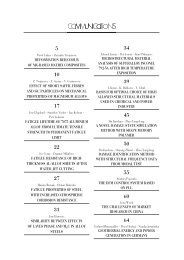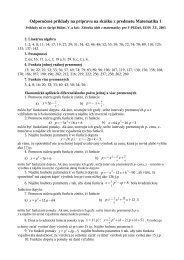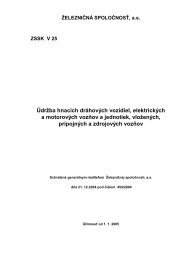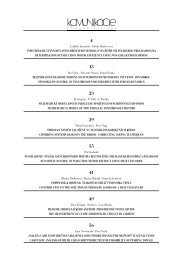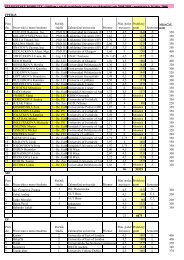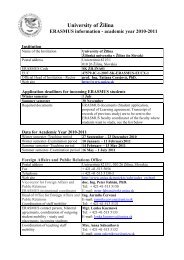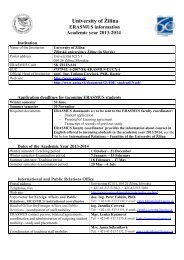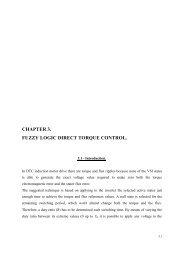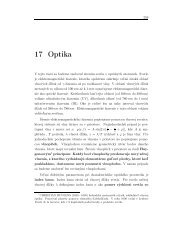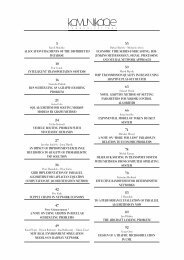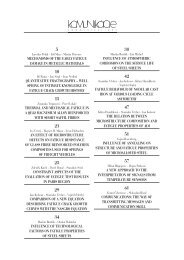simulation of torsion moment at the wheel set of the railway vehicle ...
simulation of torsion moment at the wheel set of the railway vehicle ...
simulation of torsion moment at the wheel set of the railway vehicle ...
You also want an ePaper? Increase the reach of your titles
YUMPU automatically turns print PDFs into web optimized ePapers that Google loves.
REVIEWMiloslav Klinko – Juraj Grencik *TILTING BODY VEHICLES ON SLOVAK RAILWAYS – POTENTIALFOR USE AND PARAMETERS TO BE CONSIDEREDCompetition between various transport modes has been a characteristic fe<strong>at</strong>ure <strong>of</strong> <strong>the</strong> last decades not only in <strong>the</strong> world yet in Slovakia.Passenger rail transport proves to be most suitable for medium distances with high traffic intensity. In Slovakia this is valid first <strong>of</strong> all forBr<strong>at</strong>islava – Zilina – Kosice line. One solution for increasing travel speed and ride comfort is using <strong>the</strong> tilting body trains. In <strong>the</strong> paper <strong>the</strong>oreticalconsider<strong>at</strong>ions for use <strong>of</strong> tilting body <strong>vehicle</strong>s are presented. On <strong>the</strong> example <strong>of</strong> Zilina – Kosice <strong>railway</strong> line we show a potential forremarkable reduction <strong>of</strong> travel time which is <strong>the</strong> most expected benefit <strong>of</strong> <strong>the</strong> new train technology, But we present also parameters whichshould be considered when thinking about use <strong>of</strong> new technology.1. IntroductionCompetition between various transport modes has been a characteristicfe<strong>at</strong>ure <strong>of</strong> <strong>the</strong> last decades not only in <strong>the</strong> world yet inSlovakia. Road and air transport are continually growing while<strong>railway</strong>s seem to be declining. However, <strong>railway</strong> transport is alwaysproclaimed to be a more environmental friendly and more efficientthan <strong>the</strong> o<strong>the</strong>r ones, thus giving <strong>at</strong> least verbal support. But<strong>railway</strong> transport itself has to prove its benefits showing in realitywhich parameters are better comparing with o<strong>the</strong>r modes as wellelimin<strong>at</strong>e its weaknesses. Passenger rail transport proves to bemost suitable for medium distances with high traffic intensity. InSlovakia this is valid first <strong>of</strong> all for Br<strong>at</strong>islava – Zilina – Kosiceline, but o<strong>the</strong>r lines, especially connections to <strong>the</strong> Czech Republicare <strong>of</strong> interest as well.In sixties <strong>of</strong> <strong>the</strong> 20 th century most <strong>of</strong> leading <strong>railway</strong>s in <strong>the</strong>world realised th<strong>at</strong> if <strong>the</strong> <strong>railway</strong> traffic should withhold in competitionwith o<strong>the</strong>r traffic modes than passenger travel times shouldhave been reduced substantially.High-speed <strong>railway</strong> track can not be a universal solution forincreasing speed. In a country with high popul<strong>at</strong>ion or mountainousterrain, or where government is not much in favour <strong>of</strong> investmentsinto a new <strong>railway</strong> infrastructure, <strong>railway</strong> management haveto find ano<strong>the</strong>r way for ensuring <strong>the</strong> competitive travel speed.As an example <strong>of</strong> market pressure is th<strong>at</strong> in this situ<strong>at</strong>ion<strong>vehicle</strong> designers were challenged to solve somehow <strong>the</strong> constraintsgiven by conventional technology, geographical and financial conditions.In leading countries <strong>of</strong> Europe, North America and Japan<strong>the</strong>se problems were solved by development <strong>of</strong> a system usingtilting <strong>vehicle</strong> bodies th<strong>at</strong> enabled <strong>the</strong> train running in curves <strong>at</strong>a higher speed.2. Theoretical background <strong>of</strong> body tiltingand running in curveAccording to <strong>the</strong> second Newton’s law, a body continues inits movement until external force is acting on it. As a consequence<strong>of</strong> external force action, a body will change its movement velocityand degree <strong>of</strong> this change is called acceler<strong>at</strong>ion.Passenger trains normally have acceler<strong>at</strong>ion/ deceler<strong>at</strong>ion upto about 7 – 9 % gravity force (9 % g). This is given by adhesionacting between <strong>the</strong> <strong>wheel</strong> and rail.For acceptable acceler<strong>at</strong>ion with respect to passenger comfort<strong>the</strong> maximum <strong>of</strong> something less than 10 % g is considered.While instead <strong>of</strong> acceler<strong>at</strong>ion/deceler<strong>at</strong>ion on a straight tracka train is turning into curve, <strong>the</strong> Newton law is still valid. Passengerbodies tend to continue in a straight line while <strong>the</strong> effect <strong>of</strong>transversal forces acceler<strong>at</strong>es <strong>the</strong>m in a new direction.This “transversal acceler<strong>at</strong>ion” is more perceived by passengersthan deceler<strong>at</strong>ion or acceler<strong>at</strong>ion r<strong>at</strong>e. It occurs very frequentlyon a line with curves and its magnitude depends on <strong>the</strong> trackshape and train velocity.Same as acceler<strong>at</strong>ion, <strong>the</strong> transversal acceler<strong>at</strong>ion can beexpressed in % g. Normally <strong>the</strong> transversal acceler<strong>at</strong>ion maximumvalue is 7 % g, which roughly corresponds to <strong>the</strong> train brakingfrom speed <strong>of</strong> 160 km/h. In Switzerland, <strong>the</strong> country with <strong>railway</strong>* Miloslav Klinko 1 , Juraj Grencik 21 Department for Organiz<strong>at</strong>ion and Management, General-director<strong>at</strong>e ZSR, Br<strong>at</strong>islava, Slovakia, E-mail: Klinko.Miloslav@zsr.sk2 Department <strong>of</strong> Transport and Oper<strong>at</strong>ing Technics, Faculty <strong>of</strong> Mechanical Engineering, University <strong>of</strong> Zilina, SlovakiaCOMMUNICATIONS 3/2008 ●45



